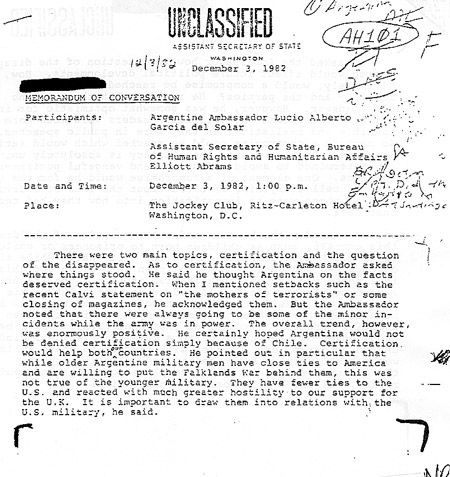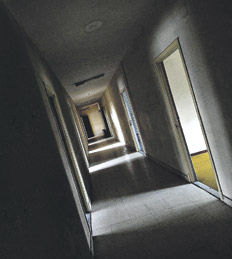Miércoles, 16 de noviembre de 2011
La periodista de Página/12 Victoria Ginzberg declaró en el juicio sobre el robo de bebés
Pruebas del plan sistemático
Fue convocada por una nota escrita en 2002 referida a los documentos desclasificados por el Departamento de Estado de Estados Unidos. Uno de los papeles revela que el dictador Reynaldo Bignone reconocía en 1982 la apropiación de bebés y se negaba a devolver a los niños a sus familias.
“Toqué con el embajador el tema de los niños, como
los chicos nacidos en prisión o los chicos sacados a sus familias
durante la guerra sucia. Mientras los desaparecidos estaban muertos,
estos niños estaban vivos y esto era, en un sentido, el más grave
problema humanitario. El embajador coincidió completamente y ya había
hablado esto con su ministro de Relaciones Exteriores y su presidente.
Ellos no rechazaron su visión, pero señalaron el problema de, por
ejemplo, quitar los chicos a sus padres adoptivos.” El párrafo fue
escrito por Elliot Abrams, de la oficina de derechos humanos de la
Subsecretaría de Estado norteamericana. Figura en uno de los documentos
desclasificados por los Estados Unidos en 2002 que fue publicado en ese
momento por Página/12. Se trata de una prueba de la existencia de un
plan sistemático para apropiarse de los hijos de desaparecidos, ya que
demuestra que el dictador Reynaldo Bignone estaba al tanto del “tema” de
los niños apropiados y se negaba a devolverlos a sus familiares para no
“quitar a los chicos de sus padres adoptivos”. La periodista de
Página/12 Victoria Ginzberg declaró ayer en el juicio oral que lleva
adelante el Tribunal Oral Federal 6 y, además de ratificar el contenido
de las notas publicadas en 2002 por este diario, profundizó acerca de
las menciones a los niños desaparecidos que hay en los papeles del
Departamento de Estado de los Estados Unidos.
Uno de los documentos utilizados en la nota titulada “El embajador y
el plan sistemático”, del 23 de agosto de 2002, por la que fue
convocada la periodista, da cuenta de que el 3 de diciembre de 1982, a
la una del mediodía, el por entonces embajador argentino en Estados
Unidos, Lucio Alberto García del Solar, se reunió con Abrams en la
confitería Jockey Club, en el hotel Ritz-Carlton de Washington. “Había
dos temas principales, la certificación (una especie de certificado de
buena conducta) y la cuestión de los desaparecidos”, apuntó el
funcionario estadounidense al elaborar el memorándum en el que relató el
encuentro.
Luego del análisis político, Abrams introdujo el tema de los niños
desaparecidos. En este asunto, obtuvo la simpatía personal de García del
Solar pero el rechazo oficial del Gobierno, encarnado en el canciller
–que por ese entonces era Juan Ramón Aguirre Lanari– y en quien ocupaba
la usurpada presidencia, Reynaldo Benito Bignone.
“Yo sugerí que ese problema debería ser manejado por la Iglesia o
por una comisión que incluya a la Iglesia, doctores, etc. Las acciones
respecto de estos chicos podrían tener un enorme contenido humanitario y
político. Nuevamente el embajador dijo que estaba completamente de
acuerdo y que tocaría este punto una vez más con Buenos Aires”, prosigue
el documento. El papel contiene un par de párrafos que aún permanecen
ocultos, ya que el gobierno norteamericano no autorizó su difusión
completa. Como podría contener información sensible para el proceso que
llevan adelante los jueces María del Carmen Roqueta, Julio Luis Panelo y
Domingo Luis Altieri, los abogados de Abuelas de Plaza de Mayo, Luciano
Hazan y Alan Iud, pidieron que se solicite la difusión completa de
dicho documento.
En agosto de 2002, el Departamento de Estado de los Estados Unidos
desclasificó 4677 cables sobre violaciones a los derechos humanos
cometidas durante la última dictadura militar en la Argentina. La
apertura de esos archivos había sido solicitada dos años antes por
Abuelas de Plaza de Mayo, Madres de Plaza de Mayo Línea Fundadora y el
Centro de Estudios Legales y Sociales durante una reunión con la
entonces secretaria de Estado Madeleine Albright en Buenos Aires. Uno de
los aportes de esos papeles fue mostrar que lo que los militares
callaban y aún ocultan en público, lo admitían sin tapujos hace 30 años
ante funcionarios de la embajada norteamericana.
- Otros cables del Departamento de Estado citados en la nota
publicada el 23 de agosto de 2002 y mencionados por la periodista de
Página/12 durante su testimonio describen que en el año 1978 los
funcionarios norteamericanos eran escépticos sobre la posibilidad de que
los militares argentinos llegaran al punto de secuestrar niños o
apropiarse de bebés nacidos durante el cautiverio de sus madres.
“Nosotros sabemos que el gobierno argentino cree que los adolescentes
son capaces de actividad terrorista y que hubo arrestos de adolescentes.
(...) Miembros del gobierno declararon a miembros de la embajada que
las operaciones no podían estar limitadas por la edad porque un grupo de
adolescentes impresionables es un área fértil para la penetración de
terroristas y subversivos. Se reportaron un número de casos de
adolescentes desaparecidos. Creemos que fueron estos elementos los que
originaron las declaraciones sobre chicos desaparecidos”, se asegura en
un documento del 29 de septiembre de 1978.
El tiempo les fue demostrando que estaban equivocados. Durante 1979
se fueron incrementando las denuncias que recibían vinculadas a los
niños desaparecidos. En un cable de enero de 1979 se mencionan 22
hechos, entre casos de adolescentes y niños pequeños, como Amaral
García, de tres años, Pablo Menna, de dos, y Simón Riquelo, de 20 días.
Dos meses después, aparece entre los papeles de interés del Departamento
de Estado un informe de Amnistía Internacional de marzo de 1979 en el
que se habla no sólo de niños desaparecidos sino también de posibles
apropiaciones de bebés nacidos durante el cautiverio de sus madres. “Hay
reportes no confirmados acerca de que a chicos secuestrados les fueron
dadas nuevas identidades y enviados a adopción. Otro grupo de mujeres,
que se hicieron conocidas como Abuelas de Plaza de Mayo, están buscando
nietos que nunca vieron. Las Abuelas sólo saben que sus hijas o nueras
estaban embarazadas cuando desaparecieron”, señalaba el organismo de
derechos humanos antes de mencionar los nombres de las mujeres que
podían haber dado a luz cuando estaban secuestradas, como Liliana
Fontana, Silvina Parodi, Beatriz Recchia, María Claudia García Irureta
Goyena, Ana María Lancillotto, Mónica María Lemos, entre otros.
- Según se desprende de otro documento, diecisiete días antes de la
reunión entre Abrams y García del Solar, las Abuelas de Plaza de Mayo se
habían reunido con funcionarios del Departamento de Estado. María
Isabel Mariani –por entonces presidenta de la institución– y Estela de
Carlotto –vicepresidenta (aparece como Carloti en el papel)– explicaron
el 15 de noviembre de 1982 “que representaban a 117 abuelas cuyos 110
nietos fueron secuestrados con sus padres desaparecidos o que nacieron
durante la detención de sus padres”. “Dijeron que hay probablemente 400
niños desaparecidos, pero que otros abuelos tienen miedo de denunciar.
Las Abuelas no pudieron obtener ninguna respuesta del gobierno argentino
sobre sus nietos. Agregaron que están convencidas de que sus nietos
están vivos y que la mayoría están ya ubicados con padres adoptivos.”
Finalmente, está el memo de la reunión entre Abrams y García del Solar.
Allí ambos dan por sentado que los niños fueron secuestrados, que fueron
entregados a “familias adoptivas”, y el embajador informa que el
dictador Bignone se resistía a la propuesta del funcionario
norteamericano que consistía en dar al tema una “salida humanitaria” (es
decir devolverlos a sus familias) con intervención de una junta médica o
de la Iglesia. Como es sabido, los represores argentinos no entregaron a
los niños buscados por las Abuelas de Plaza de Mayo. En estos 34 años
el organismo de derechos humanos logró que 105 niños, hoy jóvenes,
recuperaran su identidad. Aún quedan 400 casos sin resolver.
 Los
documentos del Departamento de Estado en los que se hace mención a las
Abuelas y al encuentro entre Elliot Abrams y Lucio García del Solar.
Los
documentos del Departamento de Estado en los que se hace mención a las
Abuelas y al encuentro entre Elliot Abrams y Lucio García del Solar.


